Input interpretation

thallium (chemical element) | lead (chemical element) | bismuth (chemical element)
Periodic table location
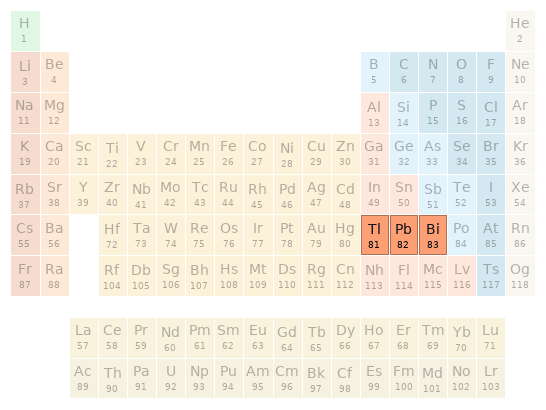
Periodic table location
Images
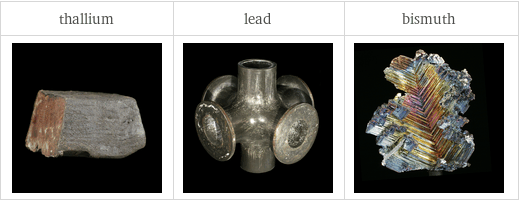
Images
Basic elemental properties
![| thallium | lead | bismuth atomic symbol | Tl | Pb | Bi atomic number | 81 | 82 | 83 short electronic configuration | [Xe]6s^24f^145d^106p^1 | [Xe]6s^24f^145d^106p^2 | [Xe]6s^24f^145d^106p^3 Aufbau diagram | 6p 5d 4f 6s | 6p 5d 4f 6s | 6p 5d 4f 6s block | p | p | p group | 13 | 14 | 15 period | 6 | 6 | 6 atomic mass | 204.38 u | 207.2 u | 208.9804 u half-life | (stable) | (stable) | 1.9×10^19 yr](../image_source/ded7d99fa566369b7ea448084a3530c1.png)
| thallium | lead | bismuth atomic symbol | Tl | Pb | Bi atomic number | 81 | 82 | 83 short electronic configuration | [Xe]6s^24f^145d^106p^1 | [Xe]6s^24f^145d^106p^2 | [Xe]6s^24f^145d^106p^3 Aufbau diagram | 6p 5d 4f 6s | 6p 5d 4f 6s | 6p 5d 4f 6s block | p | p | p group | 13 | 14 | 15 period | 6 | 6 | 6 atomic mass | 204.38 u | 207.2 u | 208.9804 u half-life | (stable) | (stable) | 1.9×10^19 yr
Thermodynamic properties
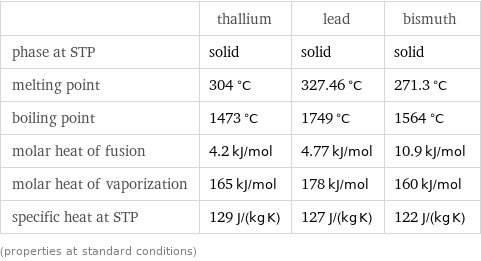
| thallium | lead | bismuth phase at STP | solid | solid | solid melting point | 304 °C | 327.46 °C | 271.3 °C boiling point | 1473 °C | 1749 °C | 1564 °C molar heat of fusion | 4.2 kJ/mol | 4.77 kJ/mol | 10.9 kJ/mol molar heat of vaporization | 165 kJ/mol | 178 kJ/mol | 160 kJ/mol specific heat at STP | 129 J/(kg K) | 127 J/(kg K) | 122 J/(kg K) (properties at standard conditions)
Material properties
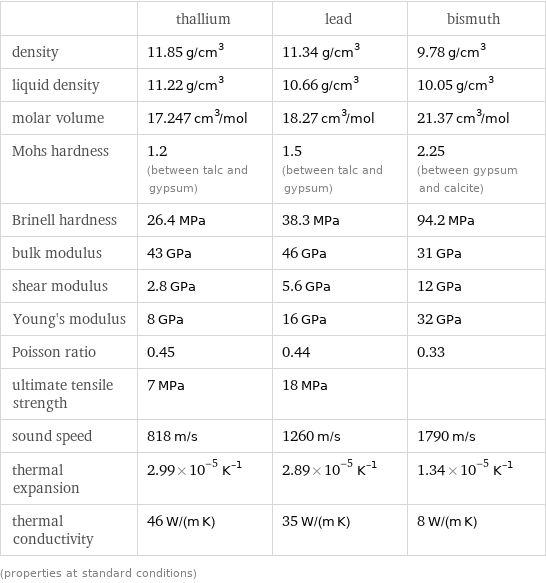
| thallium | lead | bismuth density | 11.85 g/cm^3 | 11.34 g/cm^3 | 9.78 g/cm^3 liquid density | 11.22 g/cm^3 | 10.66 g/cm^3 | 10.05 g/cm^3 molar volume | 17.247 cm^3/mol | 18.27 cm^3/mol | 21.37 cm^3/mol Mohs hardness | 1.2 (between talc and gypsum) | 1.5 (between talc and gypsum) | 2.25 (between gypsum and calcite) Brinell hardness | 26.4 MPa | 38.3 MPa | 94.2 MPa bulk modulus | 43 GPa | 46 GPa | 31 GPa shear modulus | 2.8 GPa | 5.6 GPa | 12 GPa Young's modulus | 8 GPa | 16 GPa | 32 GPa Poisson ratio | 0.45 | 0.44 | 0.33 ultimate tensile strength | 7 MPa | 18 MPa | sound speed | 818 m/s | 1260 m/s | 1790 m/s thermal expansion | 2.99×10^-5 K^(-1) | 2.89×10^-5 K^(-1) | 1.34×10^-5 K^(-1) thermal conductivity | 46 W/(m K) | 35 W/(m K) | 8 W/(m K) (properties at standard conditions)
Electromagnetic properties
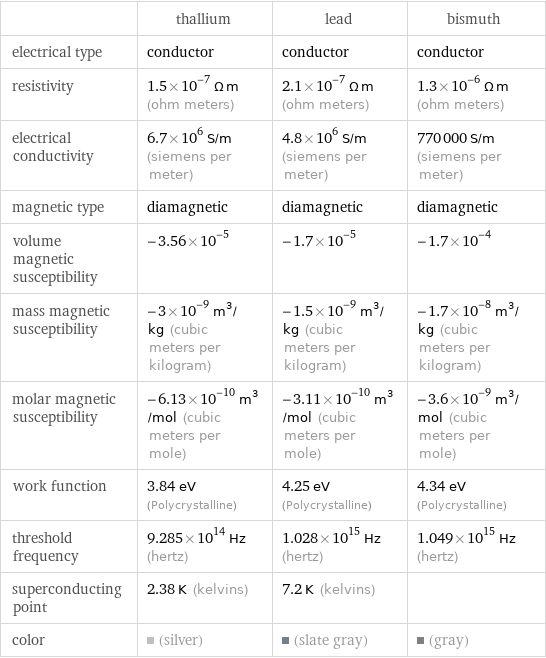
| thallium | lead | bismuth electrical type | conductor | conductor | conductor resistivity | 1.5×10^-7 Ω m (ohm meters) | 2.1×10^-7 Ω m (ohm meters) | 1.3×10^-6 Ω m (ohm meters) electrical conductivity | 6.7×10^6 S/m (siemens per meter) | 4.8×10^6 S/m (siemens per meter) | 770000 S/m (siemens per meter) magnetic type | diamagnetic | diamagnetic | diamagnetic volume magnetic susceptibility | -3.56×10^-5 | -1.7×10^-5 | -1.7×10^-4 mass magnetic susceptibility | -3×10^-9 m^3/kg (cubic meters per kilogram) | -1.5×10^-9 m^3/kg (cubic meters per kilogram) | -1.7×10^-8 m^3/kg (cubic meters per kilogram) molar magnetic susceptibility | -6.13×10^-10 m^3/mol (cubic meters per mole) | -3.11×10^-10 m^3/mol (cubic meters per mole) | -3.6×10^-9 m^3/mol (cubic meters per mole) work function | 3.84 eV (Polycrystalline) | 4.25 eV (Polycrystalline) | 4.34 eV (Polycrystalline) threshold frequency | 9.285×10^14 Hz (hertz) | 1.028×10^15 Hz (hertz) | 1.049×10^15 Hz (hertz) superconducting point | 2.38 K (kelvins) | 7.2 K (kelvins) | color | (silver) | (slate gray) | (gray)
Reactivity
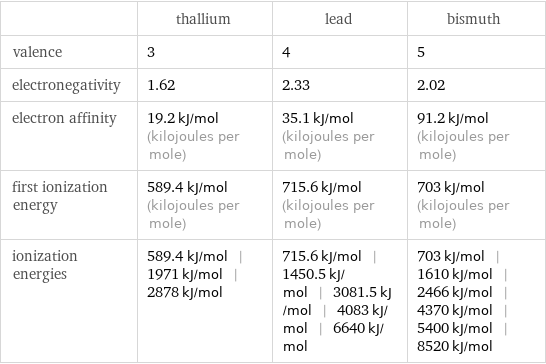
| thallium | lead | bismuth valence | 3 | 4 | 5 electronegativity | 1.62 | 2.33 | 2.02 electron affinity | 19.2 kJ/mol (kilojoules per mole) | 35.1 kJ/mol (kilojoules per mole) | 91.2 kJ/mol (kilojoules per mole) first ionization energy | 589.4 kJ/mol (kilojoules per mole) | 715.6 kJ/mol (kilojoules per mole) | 703 kJ/mol (kilojoules per mole) ionization energies | 589.4 kJ/mol | 1971 kJ/mol | 2878 kJ/mol | 715.6 kJ/mol | 1450.5 kJ/mol | 3081.5 kJ/mol | 4083 kJ/mol | 6640 kJ/mol | 703 kJ/mol | 1610 kJ/mol | 2466 kJ/mol | 4370 kJ/mol | 5400 kJ/mol | 8520 kJ/mol
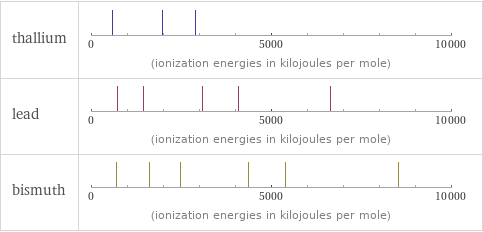
Reactivity
Atomic properties
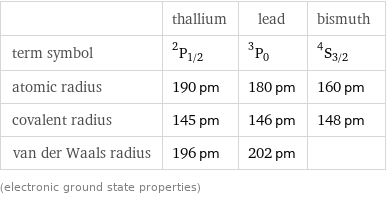
| thallium | lead | bismuth term symbol | ^2P_(1/2) | ^3P_0 | ^4S_(3/2) atomic radius | 190 pm | 180 pm | 160 pm covalent radius | 145 pm | 146 pm | 148 pm van der Waals radius | 196 pm | 202 pm | (electronic ground state properties)
Abundances
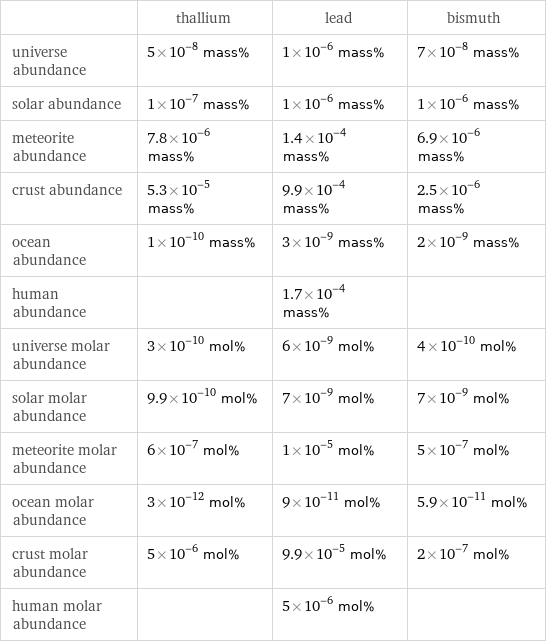
| thallium | lead | bismuth universe abundance | 5×10^-8 mass% | 1×10^-6 mass% | 7×10^-8 mass% solar abundance | 1×10^-7 mass% | 1×10^-6 mass% | 1×10^-6 mass% meteorite abundance | 7.8×10^-6 mass% | 1.4×10^-4 mass% | 6.9×10^-6 mass% crust abundance | 5.3×10^-5 mass% | 9.9×10^-4 mass% | 2.5×10^-6 mass% ocean abundance | 1×10^-10 mass% | 3×10^-9 mass% | 2×10^-9 mass% human abundance | | 1.7×10^-4 mass% | universe molar abundance | 3×10^-10 mol% | 6×10^-9 mol% | 4×10^-10 mol% solar molar abundance | 9.9×10^-10 mol% | 7×10^-9 mol% | 7×10^-9 mol% meteorite molar abundance | 6×10^-7 mol% | 1×10^-5 mol% | 5×10^-7 mol% ocean molar abundance | 3×10^-12 mol% | 9×10^-11 mol% | 5.9×10^-11 mol% crust molar abundance | 5×10^-6 mol% | 9.9×10^-5 mol% | 2×10^-7 mol% human molar abundance | | 5×10^-6 mol% |